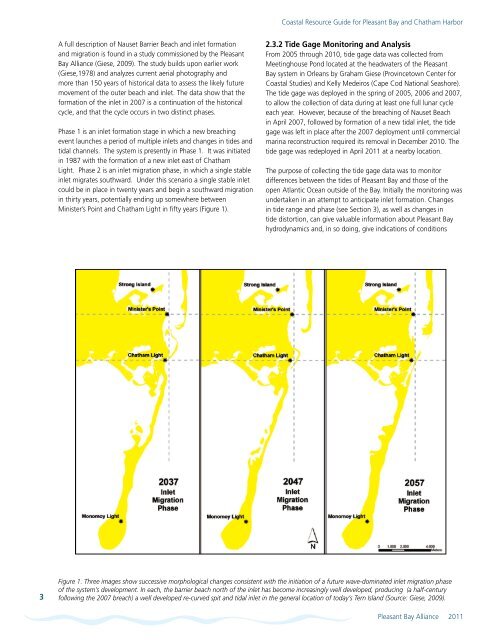Coastal Resource Guide Pleasant Bay and ... - Town to Chatham
Coastal Resource Guide Pleasant Bay and ... - Town to Chatham
Coastal Resource Guide Pleasant Bay and ... - Town to Chatham
You also want an ePaper? Increase the reach of your titles
YUMPU automatically turns print PDFs into web optimized ePapers that Google loves.
<strong>Coastal</strong> <strong>Resource</strong> <strong>Guide</strong> for <strong>Pleasant</strong> <strong>Bay</strong> <strong>and</strong> <strong>Chatham</strong> HarborA full description of Nauset Barrier Beach <strong>and</strong> inlet formation<strong>and</strong> migration is found in a study commissioned by the <strong>Pleasant</strong><strong>Bay</strong> Alliance (Giese, 2009). The study builds upon earlier work(Giese,1978) <strong>and</strong> analyzes current aerial pho<strong>to</strong>graphy <strong>and</strong>more than 150 years of his<strong>to</strong>rical data <strong>to</strong> assess the likely futuremovement of the outer beach <strong>and</strong> inlet. The data show that theformation of the inlet in 2007 is a continuation of the his<strong>to</strong>ricalcycle, <strong>and</strong> that the cycle occurs in two distinct phases.Phase 1 is an inlet formation stage in which a new breachingevent launches a period of multiple inlets <strong>and</strong> changes in tides <strong>and</strong>tidal channels. The system is presently in Phase 1. It was initiatedin 1987 with the formation of a new inlet east of <strong>Chatham</strong>Light. Phase 2 is an inlet migration phase, in which a single stableinlet migrates southward. Under this scenario a single stable inletcould be in place in twenty years <strong>and</strong> begin a southward migrationin thirty years, potentially ending up somewhere betweenMinister’s Point <strong>and</strong> <strong>Chatham</strong> Light in fifty years (Figure 1).2.3.2 Tide Gage Moni<strong>to</strong>ring <strong>and</strong> AnalysisFrom 2005 through 2010, tide gage data was collected fromMeetinghouse Pond located at the headwaters of the <strong>Pleasant</strong><strong>Bay</strong> system in Orleans by Graham Giese (Province<strong>to</strong>wn Center for<strong>Coastal</strong> Studies) <strong>and</strong> Kelly Medeiros (Cape Cod National Seashore).The tide gage was deployed in the spring of 2005, 2006 <strong>and</strong> 2007,<strong>to</strong> allow the collection of data during at least one full lunar cycleeach year. However, because of the breaching of Nauset Beachin April 2007, followed by formation of a new tidal inlet, the tidegage was left in place after the 2007 deployment until commercialmarina reconstruction required its removal in December 2010. Thetide gage was redeployed in April 2011 at a nearby location.The purpose of collecting the tide gage data was <strong>to</strong> moni<strong>to</strong>rdifferences between the tides of <strong>Pleasant</strong> <strong>Bay</strong> <strong>and</strong> those of theopen Atlantic Ocean outside of the <strong>Bay</strong>. Initially the moni<strong>to</strong>ring wasundertaken in an attempt <strong>to</strong> anticipate inlet formation. Changesin tide range <strong>and</strong> phase (see Section 3), as well as changes intide dis<strong>to</strong>rtion, can give valuable information about <strong>Pleasant</strong> <strong>Bay</strong>hydrodynamics <strong>and</strong>, in so doing, give indications of conditions3Figure 1. Three images show successive morphological changes consistent with the initiation of a future wave-dominated inlet migration phaseof the system’s development. In each, the barrier beach north of the inlet has become increasingly well developed, producing (a half-centuryfollowing the 2007 breach) a well developed re-curved spit <strong>and</strong> tidal inlet in the general location of <strong>to</strong>day’s Tern Isl<strong>and</strong> (Source: Giese, 2009).<strong>Pleasant</strong> <strong>Bay</strong> Alliance 2011
















